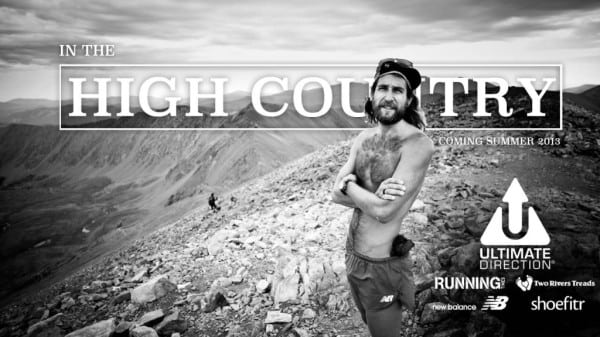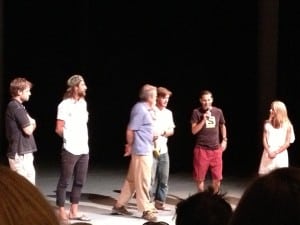In the High Country premiered on July 19 in Colorado. Just before 7:00 pm, the athletic crowd funneled into the dimly lit performance space and took their seats in front of a large screen.
The lights dimmed a bit more to signal the audience to lower their voices. Buzz Burrell, Ultimate Direction guru and the evening’s ringmaster, gave an introduction to the film and its maker, Joel Wolpert. The crowd was ready to see the 30-minute show. [Enjoy the In The High Country trailer:]
The film was broken down into five parts. The first chapter, titled “Roots,” takes place where TK’s passion for running began, in the small, farming town of Niobrara, Nebraska. For several minutes, the camera follows a bronze, shirtless Tony running around Nebraska’s dirt roads while he narrates. Through visuals and narration, the audience gets an idea of where and how his love for the outdoors started. He narrates that, “Home is what defines us.” With that, the scenery changes to the mountains of Colorado. The camera follows Tony traversing the First Flatiron, then slowly zooms in close to his face as he scrambles up the rock. Squinting, he looks for his next move. The camera pans out and reveals a vast landscape before it transitions to the next chapter.
“The Search,” the second chapter of the movie, is all about Longs Peak. In this short chapter, the audience sees even more images of Tony running around the mountains. The obvious intent here to show the crowd how he is searching and cultivating a new home for himself in the wild Rockies.
The title of part three, “Vulnerability,” has the audience on the edge of their seat. Perhaps this is the part where things get dangerous. The camera follows Tony as he heads up Longs again, but this time he takes Alexander’s Chimney (which has technical sections rated 5.5 in the summertime) to the summit. Joel, with camera in tow, heads up first. Tony arrives at the crux and, searching for holds, he is visibly sketched out by the moves needed to continue on. Eventually he lands the move and proclaims that he, “hasn’t been that scared in a while, or ever maybe.”
Chapter four, “The Practice,” is intended to give a behind-the-scenes look into Tony’s life. The hardships of making the mountains your home. Black toenails. Scars! Going to physical therapy! Exercise-induced heartburn. Most ultrarunners can relate, but to those who haven’t seen these practices before were most certainly mortified.
The final chapter, “Chasing Muses,” follows Krupicka around on the First Flatiron and Longs Peak again. The music and black-and-white tones set a dramatic aura for the chapter. And, while the audience watches Tony bounce around on mountains, the narration continues to expand on the idea of “home is what defines us” by stating that when you begin to know the land and its moods, you eventually become part of the landscape. The line between self and place becomes “seamless” and the mountains become your home. With this line about coming full circle, the movie fades to credits.
The movie over, Buzz, microphone in hand, got the Q&A session underway. Buzz introduced the editor of Competitor Magazine, Brian Metzler; Tina Lewis, Leadville Trail 100 winner; and Adam Chase, Salomon athlete. They each were given a chance to talk about how much they enjoyed the film. It was clear that the audience was appreciative of their views, but everyone wanted to hear from the star. When it was time for tony to talk about the film and himself, the audience was ready to hear it. Specifically, they wanted to hear about the danger of the mountains and how fast it takes to go up the First Flatiron or Longs. Buzz spurred on this talk by asking about Krupicka’s times on the Kiener’s and the Cables Routes on Longs. Tony was more than happy to oblige to these requests. Eventually, the crowd ran out of questions and the night drew to an end.
Leaving their seats behind, the audience quickly scurried out to the lobby in hopes of talking with the stars. Maybe even getting a signed shoe or poster.
Overall, the movie was great. The music, filming, and narration were spot on. This film could easily find its way into something like the Banff Mountain Film Festival. The chapters were well thought out and it is clear that the audience is supposed to see and feel the evolution of Krupicka’s running that happens between the rolling fields of Nebraska and the high peaks of Colorado. The film’s producer and one-man film crew, Joel, does an excellent job with this. The fact that he was able to keep up with Krupicka while filming has him nearly stealing the show.
From this movie and others, it is obvious that there is a clear shift happening in trail running. The lines between trail running, mountaineering, and climbing are becoming blurred. Brian Metzler, Competitor Magazine Editor, stated that Tony is the “epitome of the change in trail running.” Whether or not that’s true, it is clear that Krupicka’s mountain pursuits are popular. He is probably the visual that people get when they think of hardcore ultrarunners. He embodies the ultrarunning look and the nomadic lifestyle nine-to-fivers yearn for. Rugged, unshaven, shirtless. Living the grunge life out of the back of a truck. Black toenails, yeah he’s got ’em. So whether he is catching a cold on a volcanic island, running up mountains shirtless in the snow, or scrambling up the First Flatiron, people love what he embodies: freedom and a seamless continuity with nature.
Resources
- Joel Wolpert’s website, on which summer 2013 screening locations around the US Mountain West will be shortly announced as well as screenings in fall 2013 and later on the US East Coast and internationally;
- Our long interview with Joel this past March; and
- The Ultimate Direction Buzz blog synopsis of In the High Country, including details on how the film was funded, music, and some fun behind-the-scenes thoughts from Buzz.
Call for Comments (from Reese and Meghan)
- For those of you who’ve seen In The High Country, what did you think? What aspects of the film did you like the most? In what areas would you have like to have seen the film expanded?
- If you’ve not seen the film, what are you looking forward to about this film? The mountainscapes? Tony’s thoughts on landscape and movement? Infusing some inspiration into your own running? Seeing the product of Joel running like he%l to keep up with Krupicka at high altitude?

[Editor’s Note (7/22/13): This article has been edited to more focus more closely on the substance of In The High Country.]

